Analysis of Potential Future Climate and Climate Extremes in the Brazos Headwaters Basin, Texas
Abstract
:1. Introduction
2. Materials and Methods
2.1. Study Site
2.2. Climate Data Input
2.3. Downscaling of GCMs Outputs
2.4. Probability Distribution of Future Climates and Extreme Indices
2.5. Meteorological Drought
3. Results and Discussion
3.1. Performance of the LARS-WG Model
3.2. Future Climate Projections and Uncertainties of GCMs
3.3. Seasonal Changes of Projected Climate
3.4. Spatial Changes in Projected Climates
3.5. Meteorological Drought Indices
3.6. Extreme Climate Indices
4. Conclusions
Acknowledgments
Author Contributions
Conflicts of Interest
References
- O’sullivan, T.M. Environmental Security is Homeland Security: Climate Disruption as the Ultimate Disaster Risk Multiplier. Risk Hazards Crisis Public Policy 2015, 6, 183–222. [Google Scholar] [CrossRef]
- Schoof, J.T. High-Resolution Projections of 21st Century Daily Precipitation for the Contiguous U.S. J. Geophys. Res. Atmos. 2015, 120, 3029–3042. [Google Scholar] [CrossRef]
- Thornton, P.K.; Ericksen, P.J.; Herrero, M.; Challinor, A.J. Climate variability and vulnerability to climate change: A review. Glob. Chang. Biol. 2014, 20, 3313–3328. [Google Scholar] [CrossRef] [PubMed]
- Haines, A.; Kovats, R.S.; Campbell-Lendrum, D.; Corvalan, C. Climate Change and Human Health: Impacts, Vulnerability and Public Health. Public Health 2006, 120, 585–596. [Google Scholar] [CrossRef] [PubMed]
- Mcgeehin, M.A.; Mirabelli, M. The Potential Impacts of Climate Variability and Change on Temperature-Related Morbidity and Mortality in the United States. Environ. Health Perspect. 2001, 109, 185–189. [Google Scholar] [CrossRef] [PubMed]
- Agarwal, A.; Babel, M.S.; Maskey, S. Analysis of Future Precipitation in the Koshi River Basin, Nepal. J. Hydrol. 2014, 513, 422–434. [Google Scholar] [CrossRef]
- Hassan, Z.; Shamsudin, S.; Harun, S. Application of SDSM and LARS-WG For Simulating and Downscaling of Rainfall and Temperature. Theor. Appl. Climatol. 2014, 116, 243–257. [Google Scholar] [CrossRef]
- Easterling, D.R.; Meehl, G.A.; Parmesan, C.; Changnon, S.A.; Karl, T.R.; Mearns, L.O. Climate extremes: Observations, modeling, and impacts. Science 2000, 289, 2068–2074. [Google Scholar] [CrossRef] [PubMed]
- Klein Tank, A.M.G.; Zwiers, F.W.; Zhang, X. Guidelines on Analysis of Extremes in a Changing Climate in Support of Informed Decisions For Adaptation, Climate Data and Monitoring; WMO-TD No. 1500; World Meteorological Organization (WMO): Geneva, Switzerland, 2009. [Google Scholar]
- Mckee, T.B.; Doesken, N.J.; Kleist, J. Others the Relationship of Drought Frequency and Duration to Time Scales. In Proceedings of the 8th Conference on Applied Climatology, Anaheim, CA, USA, 17–22 January 1993; American Meteorological Society: Boston, MA, USA, 1993; Volume 17, pp. 179–183. [Google Scholar]
- Moorhead, J.E.; Gowda, P.H.; Singh, V.P.; Porter, D.O.; Marek, T.H.; Howell, T.A.; Stewart, B.A. Identifying and evaluating a suitable index for agricultural drought monitoring in the Texas high plains. JAWRA J. Am. Water Resour. Assoc. 2015, 51, 807–820. [Google Scholar] [CrossRef]
- Van Loon, A.F. Hydrological drought explained: Hydrological drought explained. Wiley Interdiscip. Rev. Water 2015, 2, 359–392. [Google Scholar] [CrossRef]
- Edwards, D.C.; Mckee, T.B. Characteristics of 20th Century Drought in the United States at Multiple Time Scales; Atmospheric Science, Colorado State University: Fort Collins, CO, USA, 1997. [Google Scholar]
- Busuioc, A.; Von Storch, H.; Schnur, R. Verification of GCM-Generated regional seasonal precipitation for current climate and of statistical downscaling estimates under changing climate conditions. J. Clim. 1999, 12, 258–272. [Google Scholar] [CrossRef]
- Randall, D.A.; Wood, R.A.; Bony, S.; Colman, R.; Fichefet, T.; Fyfe, J.; Kattsov, V.; Pitman, A.; Shukla, J.; Srinivasan, J. Others climate models and their evaluation. In Climate Change 2007: The Physical Science Basis. Contribution of Working Group I to the Fourth Assessment Report of the IPCC (Far); Cambridge University Press: Cambridge, UK, 2007; pp. 589–662. [Google Scholar]
- Stocker, T.F.; Qin, D.; Plattner, G.K.; Tignor, M.; Allen, S.K.; Boschung, J.; Nauels, A.; Xia, Y.; Bex, B.; Midgley, B.M. IPCC, 2013: Climate Change: The Physical Science Basis. Contribution of Working Group I to the Fifth Assessment Report of the Intergovernmental Panel on Climate Change; Cambridge University Press: Cambridge, UK, 2013. [Google Scholar]
- Wilby, R.L.; Wigley, T.M.L.; Conway, D.; Jones, P.D.; Hewitson, B.C.; Main, J.; Wilks, D.S. Statistical downscaling of general circulation model output: A comparison of methods. Water Resour. Res. 1998, 34, 2995–3008. [Google Scholar] [CrossRef]
- Wilby, R.L.; Dawson, C.W. The statistical downscaling model: Insights from one decade of application. Int. J. Climatol. 2013, 33, 1707–1719. [Google Scholar] [CrossRef]
- Wilby, R.L.; Yu, D. Rainfall and temperature estimation for a data sparse region. Hydrol. Earth Syst. Sci. 2013, 17, 3937–3955. [Google Scholar] [CrossRef]
- Casanueva, A.; Herrera, S.; Fernández, J.; Gutiérrez, J.M. Towards a fair comparison of statistical and dynamical downscaling in the framework of the EURO-CORDEX initiative. Clim. Chang. 2016, 137, 411–426. [Google Scholar] [CrossRef]
- Boé, J.; Terray, L.; Habets, F.; Martin, E. Statistical and dynamical downscaling of the seine basin climate for hydro-meteorological studies. Int. J. Climatol. 2007, 27, 1643–1655. [Google Scholar] [CrossRef]
- Gutmann, E.D.; Rasmussen, R.M.; Liu, C.; Ikeda, K.; Gochis, D.J.; Clark, M.P.; Dudhia, J.; Thompson, G.A. Comparison of statistical and dynamical downscaling of winter precipitation over complex terrain. J. Clim. 2012, 25, 262–281. [Google Scholar] [CrossRef]
- Nover, D.M.; Witt, J.W.; Butcher, J.B.; Johnson, T.E.; Weaver, C.P. The effects of downscaling method on the variability of simulated watershed response to climate change in five us basins. Earth Interact. 2016, 20, 1–27. [Google Scholar] [CrossRef]
- Wilby, R.L.; Wigley, T.M.L. Downscaling general circulation model output: A review of methods and limitations. Prog. Phys. Geogr. 1997, 21, 530–548. [Google Scholar] [CrossRef]
- Hewitson, B.C.; Crane, R.G. Climate downscaling: Techniques and application. Clim. Res. 1996, 7, 85–95. [Google Scholar] [CrossRef]
- Schmidli, J.; Goodess, C.M.; Frei, C.; Haylock, M.R.; Hundecha, Y.; Ribalaygua, J.; Schmith, T. Statistical and dynamical downscaling of precipitation: An evaluation and comparison of scenarios for the european alps. J. Geophys. Res. 2007, 112, 1–20. [Google Scholar] [CrossRef]
- Dixon, K.W.; Lanzante, J.R.; Nath, M.J.; Hayhoe, K.; Stoner, A.; Radhakrishnan, A.; Balaji, V.; Gaitán, C.F. Evaluating the stationarity assumption in statistically downscaled climate projections: Is past performance an indicator of future results? Clim. Chang. 2016, 135, 395–408. [Google Scholar] [CrossRef]
- Agarwal, A.; Babel, M.S.; Maskey, S.; Shrestha, S.; Kawasaki, A.; Tripathi, N.K. Analysis of temperature projections in the Koshi River Basin, Nepal. Int. J. Climatol. 2016, 36, 266–279. [Google Scholar] [CrossRef]
- Calanca, P.; Semenov, M.A. Local-Scale climate scenarios for impact studies and risk assessments: Integration of early 21st century ensembles projections into the ELPIS database. Theor. Appl. Climatol. 2013, 113, 445–455. [Google Scholar] [CrossRef]
- Chen, H.; Guo, J.; Zhang, Z.; Xu, C.-Y. Prediction of temperature and precipitation in Sudan and south Sudan by using LARS-WG in future. Theor. Appl. Climatol. 2013, 113, 363–375. [Google Scholar] [CrossRef]
- Semenov, M. Simulation of extreme weather events by a stochastic weather generator. Clim. Res. 2008, 35, 203–212. [Google Scholar] [CrossRef]
- Semenov, M.A. Development of high-resolution UKCIP02-Based climate change scenarios in the UK. Agric. For. Meteorol. 2007, 144, 127–138. [Google Scholar] [CrossRef]
- Semenov, M.A.; Barrow, E.M. LARS-WG: A Stochastic Weather Generator for Use in Climate Impact Studies, 3rd ed.; User Manual; Available online: http://www.rothamsted.ac.uk/sites/default/files/groups/mas-models/download/LARS-WG-Manual.pdf (accessed on 1 August 2014).
- Baldys, S.; Schalla, F.E. Base Flow (1966–2009) and Streamflow Gain and Loss (2010) of the Brazos River from the New Mexico-Texas State Line to Waco, Texas; U.S. Geological Survey, Scientific Investigations Report 2011-5224; U.S. Department of the Interior: Reston, VA, USA, 2016. Available online: http://dx.doi.org/10.3133/sir20115224 (accessed on 5 July 2016).
- Global Weather Data for SWAT. Available online: http://globalweather.tamu.edu/ (accessed on 1 December 2014).
- Saha, S.; Moorthi, S.; Pan, H.L.; Wu, X.; Wang, J.; Nadiga, S.; Tripp, P.; Kistler, R.; Woollen, J.; Behringer, D.; et al. The NCEP climate forecast system reanalysis. Bull. Am. Meteorol. Soc. 2010, 91, 1015–1057. [Google Scholar] [CrossRef]
- Dile, Y.T.; Srinivasan, R. Evaluation of CFSR climate data for hydrologic prediction in data-scarce watersheds: An Application in the Blue Nile River basin. JAWRA J. Am. Water Resour. Assoc. 2014, 50, 1226–1241. [Google Scholar] [CrossRef]
- Fuka, D.R.; Walter, M.T.; Macalister, C.; Degaetano, A.T.; Steenhuis, T.S.; Easton, Z.M. Using the climate forecast system reanalysis as weather input data for watershed models: Using CFSR as weather input data for watershed models. Hydrol. Process. 2014, 28, 5613–5623. [Google Scholar] [CrossRef]
- Knutti, R.; Sedláček, J. Robustness and uncertainties in the new CMIP5 climate model projections. Nat. Clim. Chang. 2012, 3, 369–373. [Google Scholar] [CrossRef]
- Semenov, M.; Stratonovitch, P. Use of multi-model ensembles from global climate models for assessment of climate change impacts. Clim. Res. 2010, 41, 1–14. [Google Scholar] [CrossRef]
- R Core Team. R: A Language and Environment for Statistical Computing; R Foundation for Statistical Computing: Vienna, Austria, 2016; Available online: https://www.r-project.org/ (accessed on 5 May 2016).
- Sillmann, J.; Kharin, V.V.; Zwiers, F.W.; Zhang, X.; Bronaugh, D. Climate extremes indices in the CMIP5 multimodel ensemble: Part 2. Future climate projections: CMIP5 projections of extremes indices. J. Geophys. Res. Atmos. 2013, 118, 2473–2493. [Google Scholar] [CrossRef]
- Quiring, S.M. Monitoring drought: An evaluation of meteorological drought indices. Geogr. Compass 2009, 3, 64–88. [Google Scholar] [CrossRef]
- United States Drought Monitor: U.S. Drought Monitor Classification Scheme. Available online: http://droughtmonitor.unl.edu/aboutus/classificationscheme.aspx (accessed on 15 May 2016).
- Singh, D.; Tsiang, M.; Rajaratnam, B.; Diffenbaugh, N.S. Precipitation extremes over the continental united states in a transient, high-resolution, ensemble climate model experiment: U.S. precipitation extremes with warming. J. Geophys. Res. Atmos. 2013, 118, 7063–7086. [Google Scholar] [CrossRef]
- Ford, T.; Labosier, C.F. Spatial patterns of drought persistence in the southeastern United States: Drought persistence in the southeast. Int. J. Climatol. 2014, 34, 2229–2240. [Google Scholar] [CrossRef]
- Arriaga-Ramírez, S.; Cavazos, T. Regional trends of daily precipitation indices in Northwest Mexico and Southwest United States. J. Geophys. Res. 2010, 115, 1–10. [Google Scholar] [CrossRef]
- Mishra, A.K.; Singh, V.P. Changes in extreme precipitation in Texas. J. Geophys. Res. 2010, 115, 1–29. [Google Scholar] [CrossRef]
- Mullens, E.D.; Shafer, M.; Hocker, J. Trends in heavy precipitation in the Southern USA. Weather 2013, 68, 311–316. [Google Scholar] [CrossRef]
- Mutiibwa, D.; Vavrus, S.J.; Mcafee, S.A.; Albright, T.P. Recent spatiotemporal patterns in temperature extremes across conterminous United States: CONUS Temperature extremes. J. Geophys. Res. Atmos. 2015, 120, 7378–7392. [Google Scholar] [CrossRef]
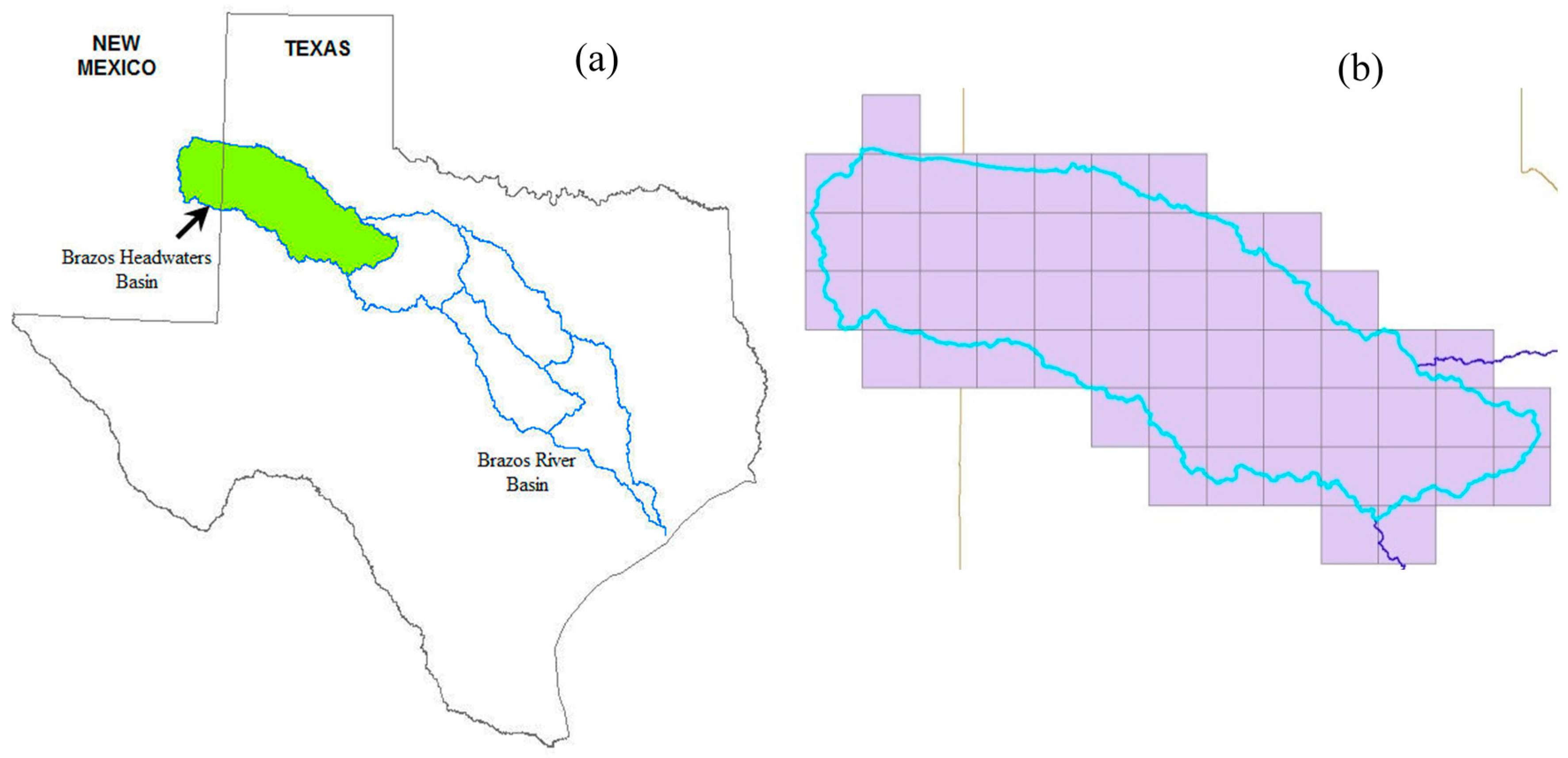


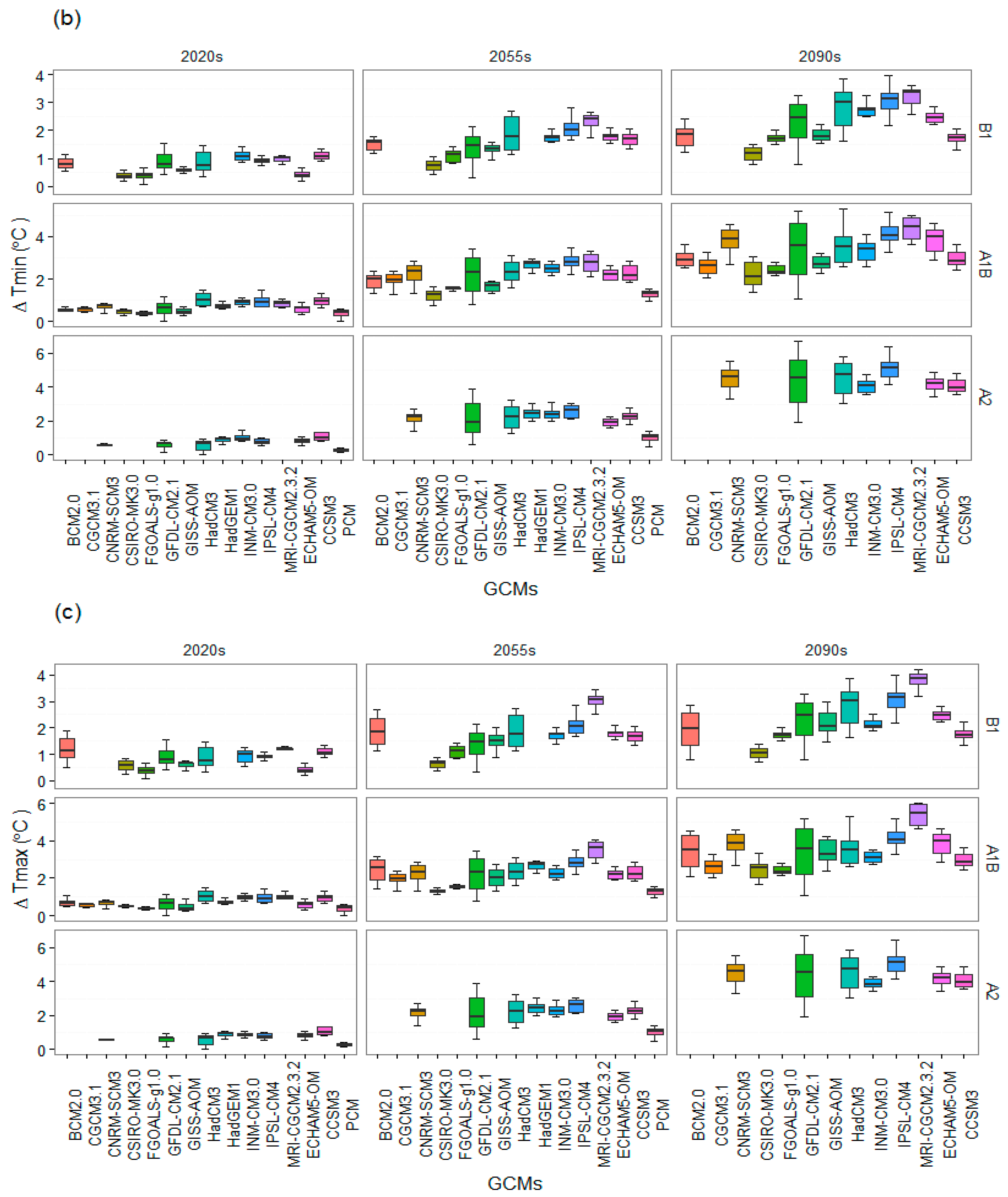
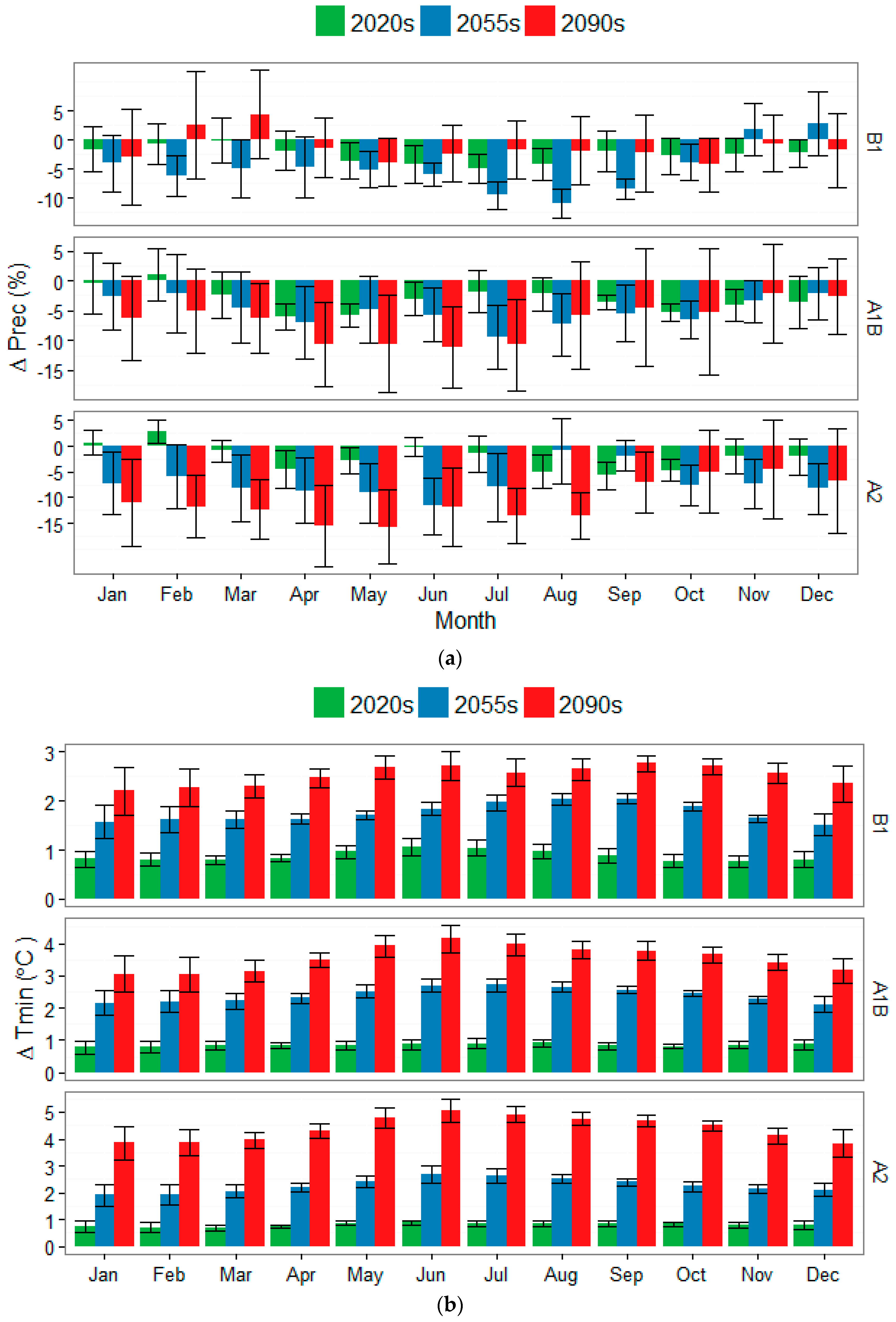
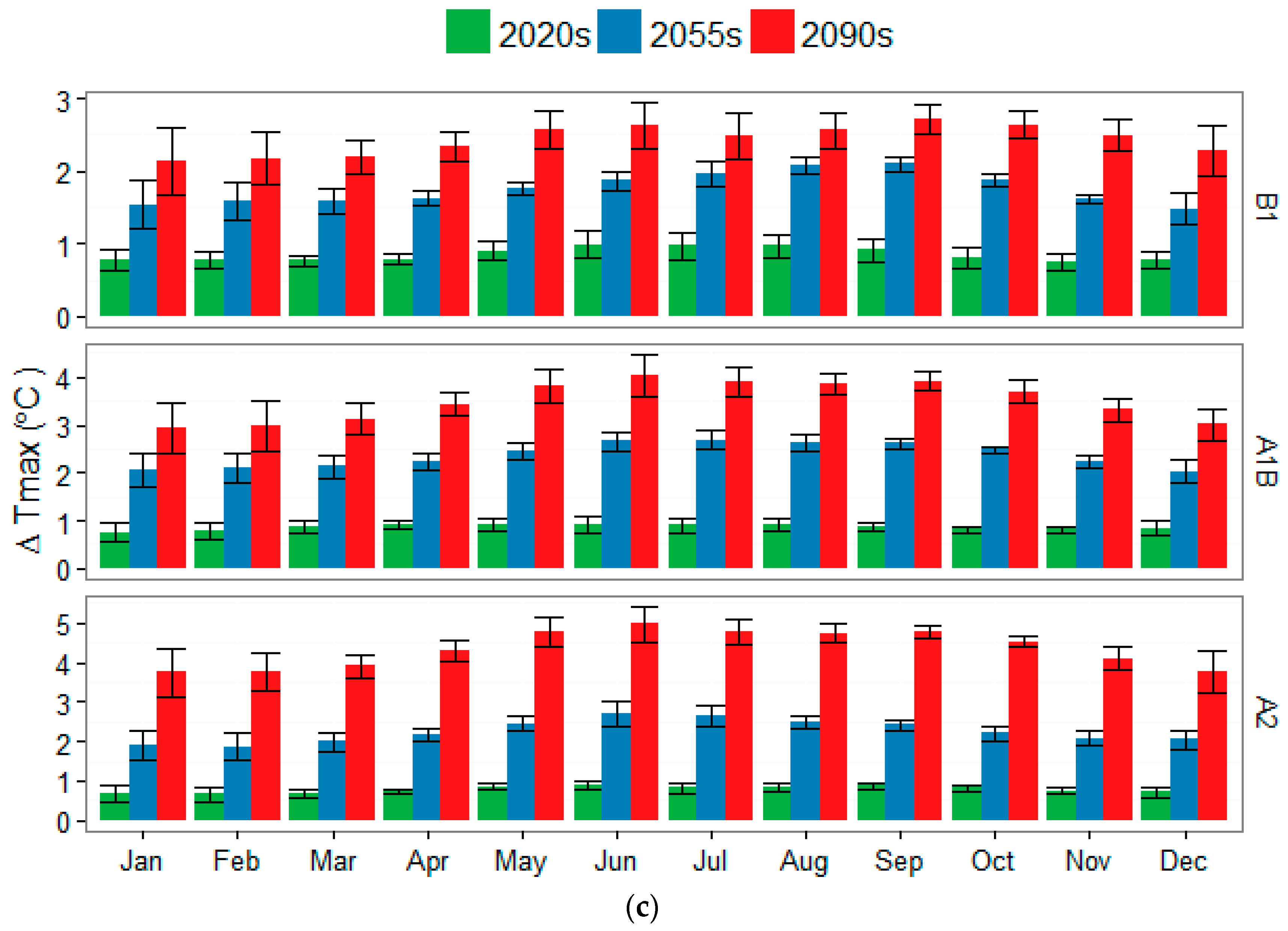

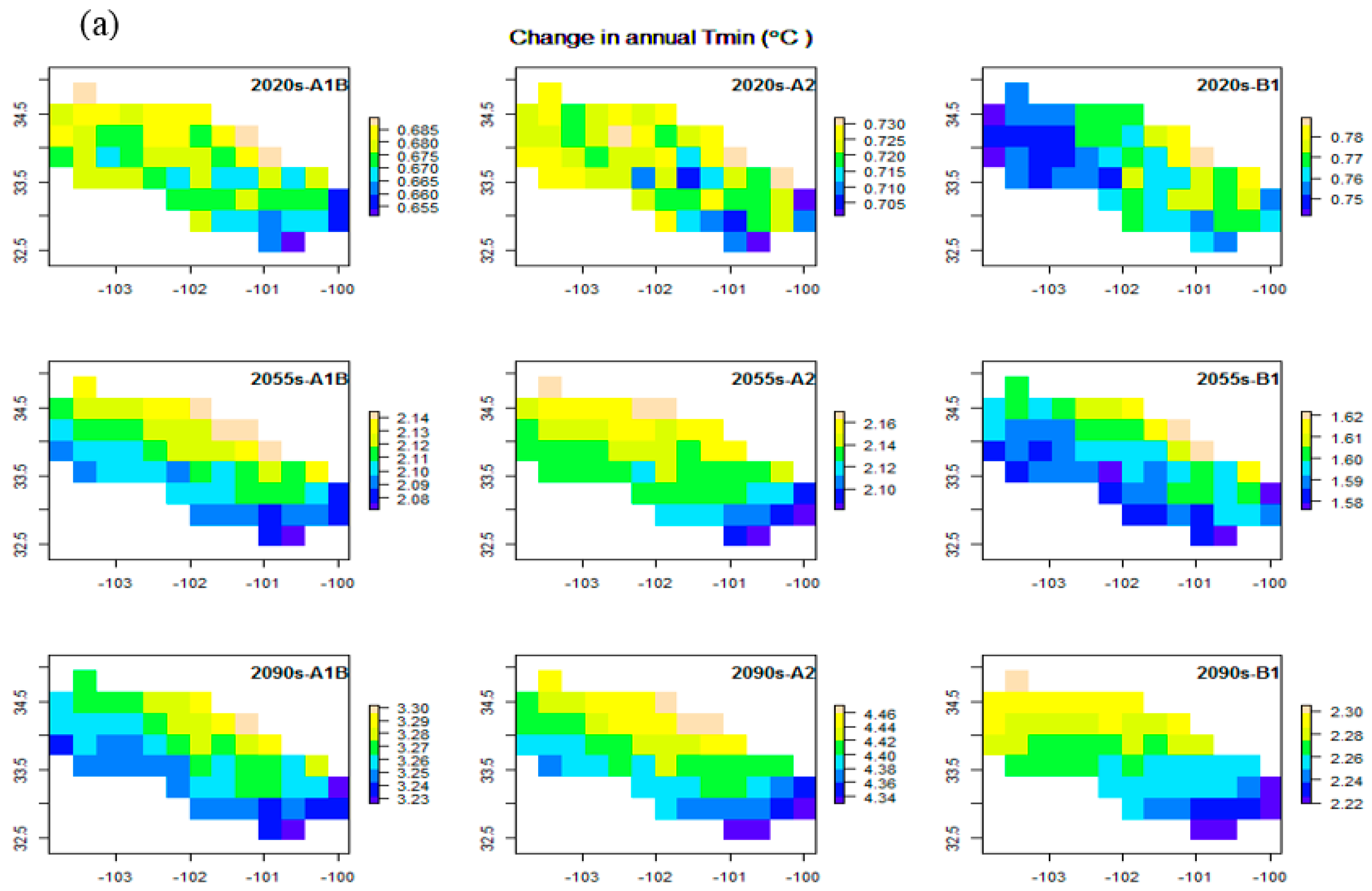
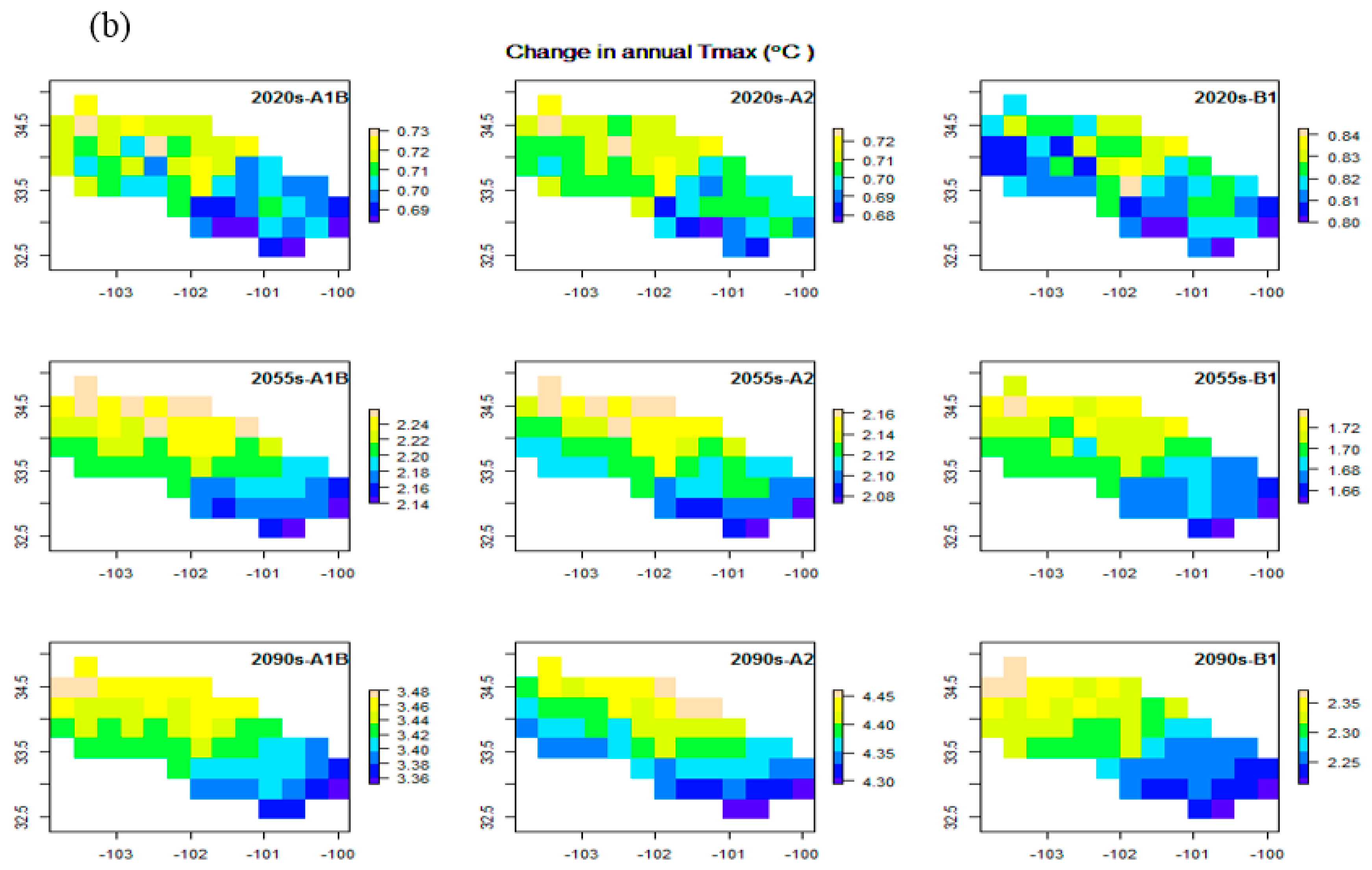

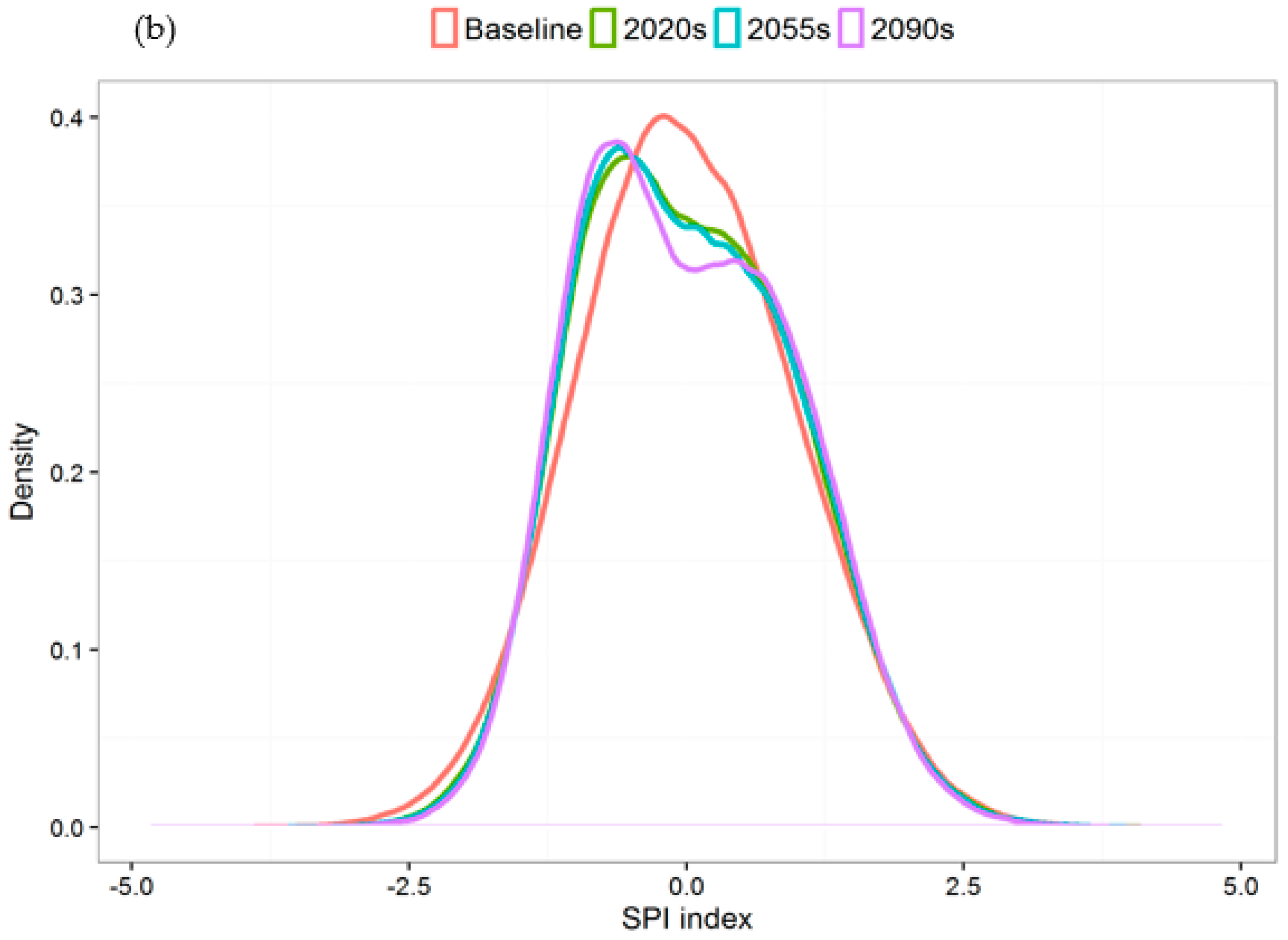
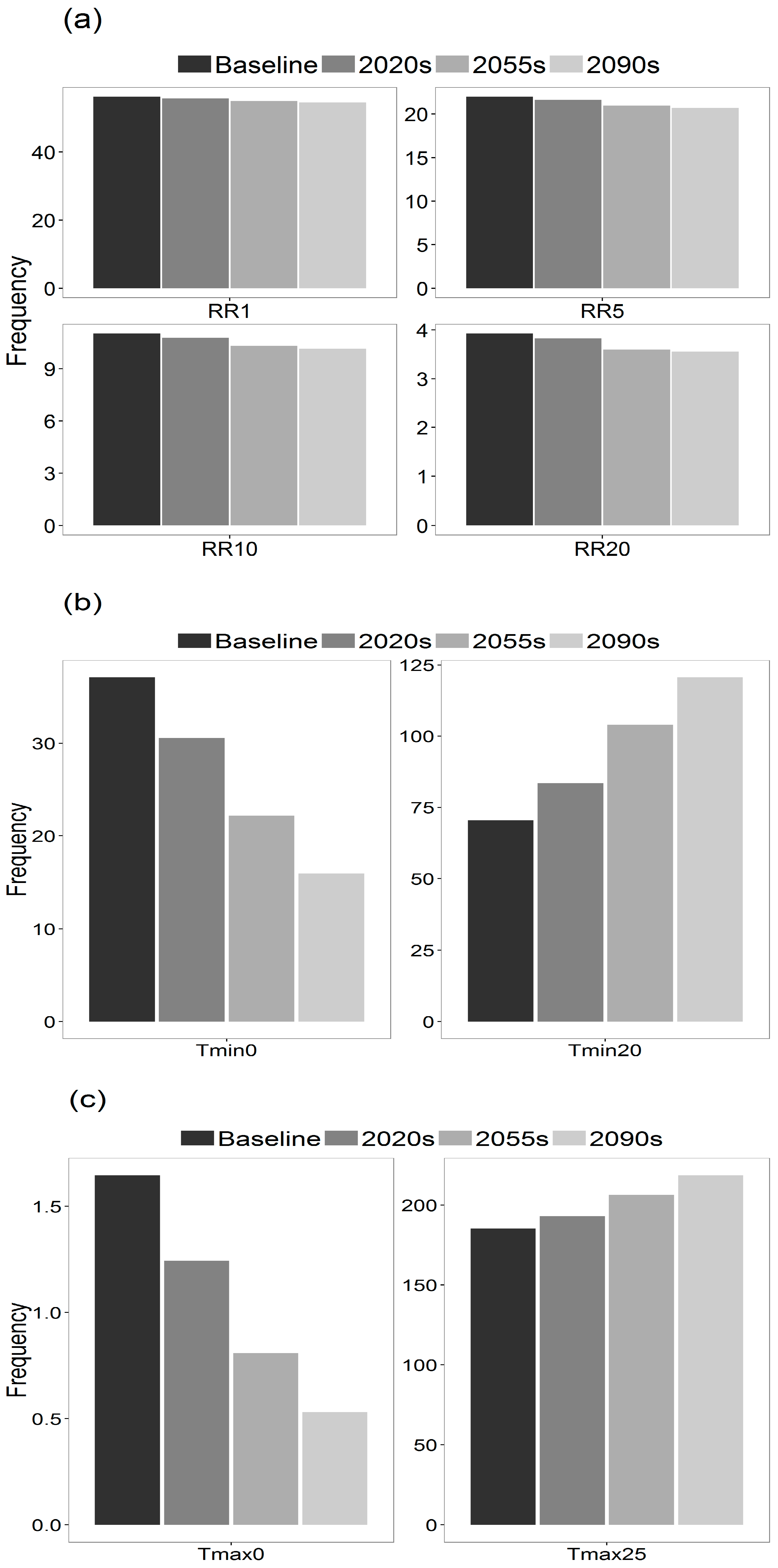
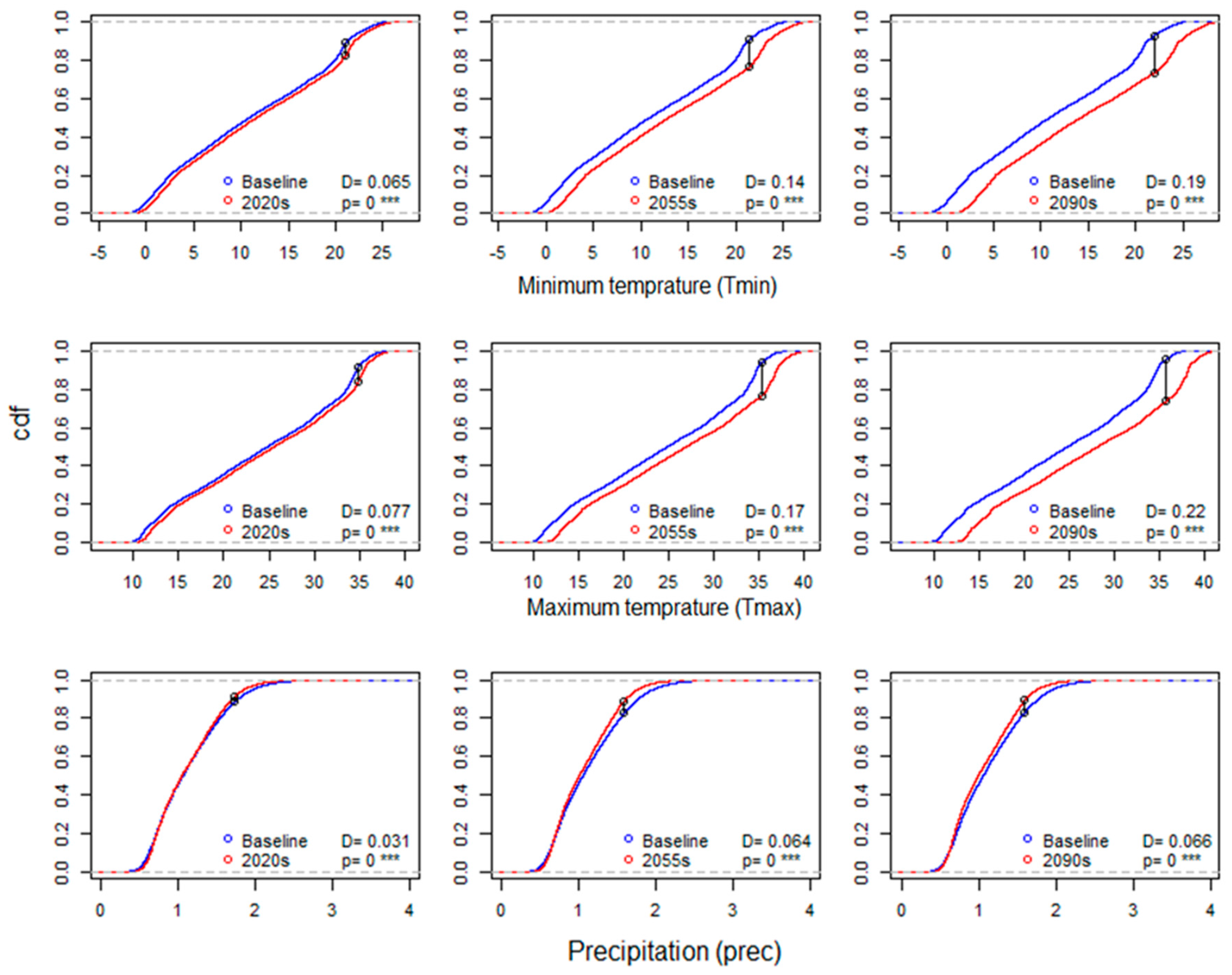
| GCMS | Country | Resolution | Emissions Scenarios |
|---|---|---|---|
| BCM2.0 | BCCR, Norway | 1.9° × 1.9° | A1B and B1 |
| CGCM3.1 | CCCMA, Canada | 1.9° × 1.9° | A1B |
| CNRM-CM3 | CNRM, France | 1.9° × 1.9° | A1B and A2 |
| CSIRO-MK3.0 | CSIRO, Australia | 1.9° × 1.9° | A1B and B1 |
| FGOALS-g1.0 | FGOALS, China | 2.8° × 2.8° | A1B and B1 |
| GFDL-CM2.1 | GFDL, USA | 2.0° × 2.5° | A1B, A2 and B1 |
| GISS-AOM | GISS, USA | 3° × 4° | A1B and B1 |
| HadCM3 | Hadley Centre, UK | 2.5° × 3.75° | A1B, A2 and B1 |
| HadGEM1 * | 1.3° × 1.9° | A1B and A2 | |
| INM-CM3.0 | INM, Russia | 4° × 5° | A1B, A2 and B1 |
| IPSL-CM4 | IPSL, France | 2.5° × 3.75° | A1B, A2 and B1 |
| MRI-CGCM2.3.2 | MRI, Japan | 2.8° × 2.8° | A1B and B1 |
| ECHAM5-OM | MPI, Germany | 1.9° × 1.9° | A1B, A2 and B1 |
| CCSM3 | NCAR, USA | 1.4° × 1.4° | A1B, A2 and B1 |
| PCM * | 2.8° × 2.8° | A1B and A2 |
| Category | Description | SPI |
|---|---|---|
| D0 | Abnormally dry | −0.5 to −0.7 |
| D1 | Moderate drought | −0.8 to −1.2 |
| D2 | Severe drought | −1.3 to −1.5 |
| D3 | Extreme drought | −1.6 to −1.9 |
| D4 | Exceptional drought | <−2.0 |
| Period | Emissions | Prec | Tmin | Tmax | ∆Prec. | ∆Tmin | ∆Tmax |
|---|---|---|---|---|---|---|---|
| (mm) | (°C) | (°C) | (%) | (°C) | (°C) | ||
| 2020s | A1B | 409.5 (±4.1) | 11.8 (±0.1) | 24.9 (±0.1) | −1.2 | 0.7 | 0.7 |
| A2 | 409.1 (±6.2) | 11.9 (±0.1) | 24.9 (±0.1) | −1.2 | 0.7 | 0.7 | |
| B1 | 402.4 (±5.2) | 11.9 (±0.1) | 25.1 (±0.1) | −2.9 | 0.8 | 0.8 | |
| 2055s | A1B | 390.8 (±5.7) | 13.3 (±0.1) | 26.4 (±0.1) | −5.7 | 2.1 | 2.2 |
| A2 | 392.1 (±10.1) | 13.3 (±0.2) | 26.4 (±0.2) | −5.4 | 2.1 | 2.1 | |
| B1 | 395.4 (±6.1) | 12.7 (±0.1) | 25.9 (±0.2) | −4.6 | 1.6 | 1.7 | |
| 2090s | A1B | 383.9 (±11.9) | 14.4 (±0.2) | 27.7 (±0.2) | −7.3 | 3.3 | 3.4 |
| A2 | 363.2 (±16.8) | 15.6 (±0.1) | 28.6 (±0.2) | −12.3 | 4.4 | 4.4 | |
| B1 | 411.2 (±9.7) | 13.4 (±0.2) | 26.5 (±0.2) | −0.7 | 2.3 | 2.3 | |
| Average (2020s) | 407 | 11.9 | 25 | −1.8 | 0.7 | 0.7 | |
| Average (2055s) | 392.8 | 13.1 | 26.3 | −5.2 | 2 | 2 | |
| Average (2090s) | 386.1 | 14.5 | 27.6 | −6.8 | 3.3 | 3.4 | |
| Baseline | 414.3 (±20) | 11.2 (±0.1) | 24.2 (±0.1) | ||||
© 2016 by the authors; licensee MDPI, Basel, Switzerland. This article is an open access article distributed under the terms and conditions of the Creative Commons Attribution (CC-BY) license (http://creativecommons.org/licenses/by/4.0/).
Share and Cite
Awal, R.; Bayabil, H.K.; Fares, A. Analysis of Potential Future Climate and Climate Extremes in the Brazos Headwaters Basin, Texas. Water 2016, 8, 603. https://doi.org/10.3390/w8120603
Awal R, Bayabil HK, Fares A. Analysis of Potential Future Climate and Climate Extremes in the Brazos Headwaters Basin, Texas. Water. 2016; 8(12):603. https://doi.org/10.3390/w8120603
Chicago/Turabian StyleAwal, Ripendra, Haimanote K. Bayabil, and Ali Fares. 2016. "Analysis of Potential Future Climate and Climate Extremes in the Brazos Headwaters Basin, Texas" Water 8, no. 12: 603. https://doi.org/10.3390/w8120603







